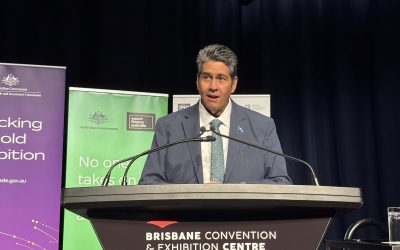The Solomon Islands, like many Pacific nations, is navigating a challenging economic environment, shaped by both global disruptions and domestic shifts. At the Australia Solomon Islands Business Forum (2-4) September 2024, Raynold Moveni, Deputy Governor of the Central Bank of Solomon Islands, presented a cautiously optimistic outlook for the country. Despite setbacks caused by the pandemic, the nation has shown resilience, with signs of recovery in key sectors. Improved financial stability, rising employment levels, and easing inflation suggest that the Solomon Islands is on a steady path towards greater economic stability.
Steady Growth Amid Challenges

Central Bank of Solomon Islands Deputy Governor Moveni speaking at the 13th Australia-Solomon-Islands Business Forum. Pic Courtesy: The Solomon Star.
Economic growth in the Solomon Islands has seen significant fluctuations in recent years. The pandemic caused a sharp contraction of 3.6 per cent in 2020, but the country managed to rebound with a 2.4 per cent growth rate in 2021, improving further to 3.0 per cent by 2023. Growth is projected to moderate to around 2.5 per cent over the medium term, signalling a steady recovery. The commodities sector, particularly forestry, agriculture, fishing, and mining, has played a critical role in driving this recovery. Despite some fluctuations, these industries remain central to the Solomon Islands’ economy, supporting both exports and domestic employment.
Employment is also on the rise, with the Solomon Islands National Provident Fund (SINPF) reporting a 5 per cent increase in contributors in the first half of 2024. This improvement reflects the country’s ability to generate jobs as economic activities pick up. However, the trade deficit remains a key challenge. While the deficit narrowed significantly from $1.6 billion in 2022 to $399 million in 2023, it still poses concerns for long-term economic health. This improvement suggests progress in balancing import and export activities, but continued efforts will be necessary to fully address this imbalance.
Financial Stability and Easing Inflation
The financial sector, as highlighted by Deputy Governor Moveni, remains robust, with the banking industry in a strong position to support economic growth. Banks have ample capital to absorb potential shocks, and liquidity levels are sufficient to ensure continued credit growth. Although foreign reserves have slightly decreased, they remain at healthy levels, offering a significant buffer to meet the country’s import needs for several months. This stability is vital to the Solomon Islands’ broader economic recovery.
Inflation, which surged to 9.5 per cent in 2022, is now easing. Forecasts suggest it will fall to 2.5 per cent by the end of 2024, driven by stabilising domestic conditions and reduced external pressures. This drop in inflation is essential for boosting household purchasing power, which had been strained by rising prices, and for creating a more stable economic environment that supports long-term growth.
As presented at the forum, while challenges such as the trade deficit and moderate growth remain, the Solomon Islands is on a solid recovery path, with a stable financial sector, easing inflation, and improving employment prospects.



